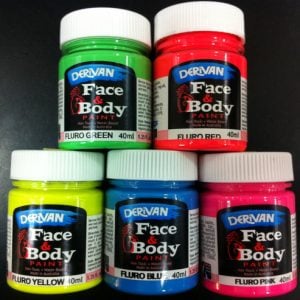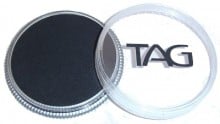Description
Do you want a face/body paint with a higher concentration of pigment? Do you want to be able to use the paint in an airbrush? Then this is the paint for you.
_x000d_
Tim Gratton’s Face and Body Paint is a professional-grade high quality cosmetic paint, that conforms to Australian and CE cosmetic regulations and Australian Standard 1647.3.
_x000d_
 We’ve also now introduced a new Iridescent colour that will add a little shimmer to the entire range. You can use the Iridescent Body and Face Paint by itself, or mix with other colours to give the paint a stunning pearlescent look. This is fantastic for creating magical effects, or adding another dimension to any design from butterflies to Spiderman.
We’ve also now introduced a new Iridescent colour that will add a little shimmer to the entire range. You can use the Iridescent Body and Face Paint by itself, or mix with other colours to give the paint a stunning pearlescent look. This is fantastic for creating magical effects, or adding another dimension to any design from butterflies to Spiderman.
_x000d_
Application
_x000d_
It is advisable to use Tim Gratton’s Face and Body Paint over a `barrier` or hand cream on the face to lessen the chance of an adverse reaction on sensitive skin. Do not use on persons with sensitive skin or skin conditions. Do not apply to open wounds. Avoid contact with eyes, nasal passages, mouth or other orifices as abrasive irritation may occur.
_x000d_
Directions
_x000d_
Using a clean palette knife or other utensil, remove as much paint from the container as necessary for the session and replace lid.
Do not return unused paint to the container! Contamination will reduce the shelf-life of your paint drastically.
_x000d_
Place on a palette or other clean non-porous surface. Mix the required secondary or tertiary colours on this palette.
_x000d_
Apply a barrier cream or hand cream to the skin before painting: this will make it even easier to remove Tim Gratton’s Face and Body Paint from the skin.
_x000d_
Apply the with a soft brush, sponge, cotton wool or cosmetic dabber. It is strongly advisable, if painting more than one face, to use a disposable applicator such as cotton wool and discard after each person – be careful not to re-immerse the applicator in the paint.
_x000d_
Do not apply the barrier cream or Tim Gratton’s Face and Body Paint too close to the eyes as both contain solid particles which may irritate the eyes.
_x000d_
Tim’s tips and tricks of the trade
_x000d_
Hairspray can be used to coat the hair before applying body paint. Hairspray can also be sprayed over the completed body painting to prevent rubbing or flaking over long periods. Avoid eyes and mouth when spraying.
_x000d_
Olive Oil can be applied with a spray atomizer over the body paint to give a silky shine or you can mix it with the metallic paint on the second coat to make it really glossy. Apply the first coat of paint without olive oil.
_x000d_
Airbrush
_x000d_
It is possible to use an airbrush for fine detail or spray gun for larger areas with Tim Gratton’s Body & Face Paint. Brilliant effects can be achieved with the use of an airbrush. All the colours and the metallics (except the gold and silver glitter) will go through the smallest of airbrushes. However, a 0.3 mm or larger size is recommended. Dilute with water up to equal parts and spray apply. An approved mask should be worn when spraying with the paints even though the paints are non-toxic.
Avoid inhalation.
_x000d_
Removal of paints stains
_x000d_
Tim Gratton’s Body & Face Paint is formulated to be easily removed from clothing. However, old clothing should be worn as some fabrics may stain. Tim Gratton’s Body & Face Paint is formulated using pigments rather than dyes as dyes tend to stain much more readily. With the thumb and forefinger of each hand slowly work the stain in a rolling action thereby releasing the paint and colour into the soapy water. Change the water as necessary and repeat washing action. Do not use hot water. Some stubborn stains may need to be soaked overnight. Tim Gratton’s Body & Face Paints are formulated to swell up and release when submerged in soapy water. Other methods of cleaning will generally only act to drive the stain in deeper. Do not boil, dry clean or use chemical solvents or thinners. Do not iron over a stain. Do not machine wash. Keep stained garments separate from other washing.
_x000d_
Removal
The face paint will wash off with soap and water. Avoid getting the face paint on clothing as even though it will not stain the skin, it may stain some fabrics.
_x000d_
Colour Mixing
All the colours may be intermixed to form bright secondary and tertiary colours.
Clean Up
Keep all brushes and utensils wet while working. Avoid letting them dry out as the face paint is much easier to remove from brushes while wet. Wash all utensils, brushes and hands with soap and water to clean up.
_x000d_
Acrylics as Facepaint (from Steven Patterson, General Manager)
_x000d_
There have recently been several posts (some old, some new) saying that `acrylics` or artists’ paints are dangerous to use on the skin and that they are carcinogenic, that is, they may cause cancer. This is not true, but deserves some explanation. Although some artist acrylics may contain pigments that could possibly be carcinogenic, it is the pigment that is the potentially harmful part, not the acrylic. However, these pigments will usually have more obvious health warnings on them than a cigarette packet, so it will not be hard to work out which are the bad ones. Of course, Derivan’s Face & Body Paint, and Tim Gratton’s products, contain none of these pigments.
_x000d_
Even with safe pigments, however, regular artist’s paint shouldn’t be used on the skin, for the same reasons that any other non-cosmetic product should not be used on the skin. Only cosmetic products made to cosmetic standards (or other therapeutic goods that are designed to go on the skin) are made using materials that are proven to be safe on the skin and can be used for pro-longed periods without any side effects.
_x000d_
For Derivan products, if they are labelled non-toxic then that’s what they are. Being `non-toxic` however does not mean that they are meant to be eaten or for that matter go on the skin. They are designed to be safe for their intended use and if a person happens to consume a small amount ‘accidentally’ or get some on their skin ‘the average person’ will have no reaction. You should keep in mind that there are people who are not ‘average’ and are hyper-sensitive to some things and they may find that the paints cause them irritation or even to become quite ill, and this can happen with many different things – even something as humble as a peanut can be quite literally life threatening to some people. With that said I can’t remember a complaint about our product (and I have been here since 1983). So non-toxic does not equal cosmetic.
_x000d_
Acrylics are not necessarily dangerous (many acrylics are approved and used in cosmetics worldwide) however it is certainly wrong to use an artist acrylic as a face paint. Only paints such as the Derivan Face & Body Paint or Tim Gratton’s Body & Face Paints that are cosmetics should be used.




